Lecturer: Prof. Stefano Mazzoleni from The BioRobotics Institute of Sant’Anna School of Advanced Studies, Pisa
By Giulia Bovassi –
Gruppo di Ricerca interdisciplinare in Neurobioetica (GdN)
Masterclass in “Neurobioethics and Roboethics”, 2nd edition, 1st lesson
Lecturer: Prof. Stefano Mazzoleni from The BioRobotics Institute of Sant’Anna School of Advanced Studies, Pisa
Abstract
The second Masterclass in Neurobioethics “Neurobioethics and Roboethics”, which will be focused this year upon the proposals coming from robotics. Robotics is a large branch of study in continuous and rapid development, not only from the industrial perspective, but also from the medical, family and private ones. Man-machine hybridization has already come about, occupies numerous daily spaces, and raises the ethical and existential questions about what we have to say about this new identity.
GdN, in partnership with the UNESCO Chair in Bioethics and Human Rights and the Science and Faith Institute, hosted in the prestigious academic headquarters of the Pontifical Athenaeum Regina Apostolorum, has undertaken a watchful, refined interdisciplinary investigation, which will continue during this and the next four years, in order to achieve the best possible result in the professional, academic research, which is dedicated to the new questions that bioethics, philosophy, anthropology, medicine, engineering, law, theology, interreligious and multicultural sciences raise for the today’s man. The studies of the neurosurgeon Sergio Canavero regarding the human head transplantation, have created an intellectual sensation.
 Dr. Stefano Mazzoleni, lecturer and Coordinator of the Bioengineering Laboratory of Rehabilitation, through his speech titled “Human-machine interaction: can robots and AI help improve our quality of life, particularly the quality of life of people with disability?”, guided the participants through the logic of robotic engineering applied to the user-help, referring especially to patients who face difficulties managing their daily routine due to their physical limits. The concern for these needs pushes biorobotics in the direction of service, which looks for the good man.
Dr. Stefano Mazzoleni, lecturer and Coordinator of the Bioengineering Laboratory of Rehabilitation, through his speech titled “Human-machine interaction: can robots and AI help improve our quality of life, particularly the quality of life of people with disability?”, guided the participants through the logic of robotic engineering applied to the user-help, referring especially to patients who face difficulties managing their daily routine due to their physical limits. The concern for these needs pushes biorobotics in the direction of service, which looks for the good man.
A similar interest in the applications and the ethics of robotics was born recently with the advent of a new engineering oriented to products’ usability, beyond the strictly industrial-mechanical context, to families and citizens’ homes. There is talk of the domestic usage of an entity built to enter into a relationship with the needs of man (an element which has been initially designed almost exclusively to accomplish difficult and complex industrial jobs).
 The very origin of the term “robot”, derived from “robota“, refers to heavy work, an index of the nature inherent in the functional-collaborative interaction with human effort, a cooperation that does not (or should not) propose replacement for optimization, namely the efficiency that takes away dignity, but rather should support the thinking subject as the true protagonist. «Observing nature to understand its needs, in the wake of what Leonardo da Vinci has done», educating future engineers in the renaissance model of their profession, so that, seeing trauma or disability, they understand how to take the opportunity to put individual skills at service of others. This fundamental assumption of biorobotics, which has close to its heart the dignity and the good of the person, is absolutely essential; it is indispensable because, without such trajectories, the “ability to make” surrenders to the causes of its birth, namely the “creating know-how” gains the probability of destroying / threatening mankind, a risk that is considered to be therefore acceptable. Cinematography and literature on biorobotics, since the ’80s and decisively surging in the 2000s, suggests new goals. Since 2000, through «bio-inspiration» many capacities not previously explored has taken shape: generation of movement through sensors; wondering why, observing natural and animal bodies to overcome their limits through robotic replication. This progress has led from rigid robotics to neurorobotics and “soft robotics.
The very origin of the term “robot”, derived from “robota“, refers to heavy work, an index of the nature inherent in the functional-collaborative interaction with human effort, a cooperation that does not (or should not) propose replacement for optimization, namely the efficiency that takes away dignity, but rather should support the thinking subject as the true protagonist. «Observing nature to understand its needs, in the wake of what Leonardo da Vinci has done», educating future engineers in the renaissance model of their profession, so that, seeing trauma or disability, they understand how to take the opportunity to put individual skills at service of others. This fundamental assumption of biorobotics, which has close to its heart the dignity and the good of the person, is absolutely essential; it is indispensable because, without such trajectories, the “ability to make” surrenders to the causes of its birth, namely the “creating know-how” gains the probability of destroying / threatening mankind, a risk that is considered to be therefore acceptable. Cinematography and literature on biorobotics, since the ’80s and decisively surging in the 2000s, suggests new goals. Since 2000, through «bio-inspiration» many capacities not previously explored has taken shape: generation of movement through sensors; wondering why, observing natural and animal bodies to overcome their limits through robotic replication. This progress has led from rigid robotics to neurorobotics and “soft robotics.
 Currently, biorobotics explains the medical implant of organs and artificial limbs where they are absent, bringing in close contact doctors, researchers, scientists, engineers whose work will be a qualitative improvement of the life of patients for whom biorobotics will be an advantage. For example, the robotic hand, whose functioning Dr. Mazzoleni has highlighted, and which could be summarized in the interception of the electric impulse, thanks to the study of nerve signals, referring to the intentionality of moving the robotic hand as the human one usually moves. Biorobotics also promises benefits such as smaller incisions, shorter hospitalization, reduced risk of infection, less pain, faster healing times.
Currently, biorobotics explains the medical implant of organs and artificial limbs where they are absent, bringing in close contact doctors, researchers, scientists, engineers whose work will be a qualitative improvement of the life of patients for whom biorobotics will be an advantage. For example, the robotic hand, whose functioning Dr. Mazzoleni has highlighted, and which could be summarized in the interception of the electric impulse, thanks to the study of nerve signals, referring to the intentionality of moving the robotic hand as the human one usually moves. Biorobotics also promises benefits such as smaller incisions, shorter hospitalization, reduced risk of infection, less pain, faster healing times.
Asimov’s “I, Robot” presents a futuristic dystopian vision of distant worlds in which the natural and artificial cohabit a single body, a single identity or dimension. Such works move the collective imagination between nightmare and dream, fear and hope. On the one hand, the expert responds by releasing us from the anxieties related to robot’s autonomy, the exit from the calculated control, the serenity that derives from the construction of a humanoid machine, which can act (according to the dictates of the human) but it is not able to want since they learn what their creator wants to let them know.
 Considering the robot as a tool does not scare, but to think of it as similar to the human species does frighten. Prof. Mazzoleni spoke of the “Uncanny valley“, a perturbing valley, a “sudden fall” in that place where we lose the serene familiarity with objects which have a human appearance. The technical aspects and scientific disciplines treated so far have noted the positive contributions of the relationship between man and machine, but they do not remove that feeling of extraneousness and uncertainty. In this context, bioethics is called to take a buffer function thanks to the critical and rational reflection that the dialogue between research fields, near or far, can build when the object is a subject, i.e. the human being. It encourages the beneficial contribution that robotics, together with artificial intelligence, are making and are destined to cultivate. Preventive ethical vigilance should not degenerate into the trivialization of itself. Instead it is necessary to consider the hypothesis that not all philosophical-scientific movements have close to heart the integral good of the human being, so acting according to the measure of the productive, empowering or efficient advantage, even if this should force us to consider the human being as an entity not dissimilar to what everyone wants to find in his own nature, which is as a bastion of innovation. Conversing about the irreplaceable nature of the human presence in collaboration with technology is the proactive strategy implemented by this first, very rich, appointment, whose spirit resides exactly in living what we know, together with what remains ahead.
Considering the robot as a tool does not scare, but to think of it as similar to the human species does frighten. Prof. Mazzoleni spoke of the “Uncanny valley“, a perturbing valley, a “sudden fall” in that place where we lose the serene familiarity with objects which have a human appearance. The technical aspects and scientific disciplines treated so far have noted the positive contributions of the relationship between man and machine, but they do not remove that feeling of extraneousness and uncertainty. In this context, bioethics is called to take a buffer function thanks to the critical and rational reflection that the dialogue between research fields, near or far, can build when the object is a subject, i.e. the human being. It encourages the beneficial contribution that robotics, together with artificial intelligence, are making and are destined to cultivate. Preventive ethical vigilance should not degenerate into the trivialization of itself. Instead it is necessary to consider the hypothesis that not all philosophical-scientific movements have close to heart the integral good of the human being, so acting according to the measure of the productive, empowering or efficient advantage, even if this should force us to consider the human being as an entity not dissimilar to what everyone wants to find in his own nature, which is as a bastion of innovation. Conversing about the irreplaceable nature of the human presence in collaboration with technology is the proactive strategy implemented by this first, very rich, appointment, whose spirit resides exactly in living what we know, together with what remains ahead.

 How should theology interpret transhumanism? What can be said about the man’s relation to God, his spiritual striving, and his self-understanding? These are just some of the questions that emerged during the meeting on Friday April 20 during the speeches held by professors Giorgia Salatiello and Sr. Daniela Del Gaudio.
How should theology interpret transhumanism? What can be said about the man’s relation to God, his spiritual striving, and his self-understanding? These are just some of the questions that emerged during the meeting on Friday April 20 during the speeches held by professors Giorgia Salatiello and Sr. Daniela Del Gaudio. GdN coordinator Fr. Alberto Carrara, discussed how many thinkers disregard a specific vision about human nature and consequently ethical action. He insisted that human acts cannot be isolated from a relationship with freedom, responsibility and dignity, which are decisive elements for every medical action. The doctor should join, assemble, restore the functioning between the living body and the deceased donor’s body. The doctor could, erroneously, glimpse a mere “producing” in what he is doing, reducing the meeting between doctor and patient to an approach between an operator and an object. In the body transplantation case, one’s original vocation is to take care for the other. Every ill person directs his fears and hopes to the other person’s competence, letting the doctor enter his lives in a concrete act of trust, both professional and human.
GdN coordinator Fr. Alberto Carrara, discussed how many thinkers disregard a specific vision about human nature and consequently ethical action. He insisted that human acts cannot be isolated from a relationship with freedom, responsibility and dignity, which are decisive elements for every medical action. The doctor should join, assemble, restore the functioning between the living body and the deceased donor’s body. The doctor could, erroneously, glimpse a mere “producing” in what he is doing, reducing the meeting between doctor and patient to an approach between an operator and an object. In the body transplantation case, one’s original vocation is to take care for the other. Every ill person directs his fears and hopes to the other person’s competence, letting the doctor enter his lives in a concrete act of trust, both professional and human. The two interventions, “Theological Anthropology Questions about the Recent Scenarios Raised by Transhumanism” by Prof. Giorgia Salatiello (Pontifical Gregorian University) and “The Creational Destination of Man to Immortality: Identity and Resurrection” by Prof. Sr. Daniela Del Gaudio (Pontifical Urbaniana University), extended the consideration to the central points of the Trans and Posthumanist movement, and theology, in some concepts of common interest (for example immortality, life, meaning of death, of freedom, of corporeality, of the person and the task entrusted to him when God is perceived in his origins), promoting an exchange as constructive as possible. In this sense, during the first intervention some themes, particularly suggested throughout the Masterclass’s opening lectures, re-emerged, confirming the fact that, using Prof. Salatiello’s words, «transhumanism constitutes a major challenge for theological anthropology»: to embrace a vision of the human being as a creature implies that our free action is not arbitrariness (without constraints, bare of foundations); greater dependence on God implies greater freedom because God places the creature free (in the Christian conception freedom is constitutively oriented to the good). The concept of “person” is a notion that contains in itself the relationship with God, the uniqueness of the individual and, again, the free response to the loving call.
The two interventions, “Theological Anthropology Questions about the Recent Scenarios Raised by Transhumanism” by Prof. Giorgia Salatiello (Pontifical Gregorian University) and “The Creational Destination of Man to Immortality: Identity and Resurrection” by Prof. Sr. Daniela Del Gaudio (Pontifical Urbaniana University), extended the consideration to the central points of the Trans and Posthumanist movement, and theology, in some concepts of common interest (for example immortality, life, meaning of death, of freedom, of corporeality, of the person and the task entrusted to him when God is perceived in his origins), promoting an exchange as constructive as possible. In this sense, during the first intervention some themes, particularly suggested throughout the Masterclass’s opening lectures, re-emerged, confirming the fact that, using Prof. Salatiello’s words, «transhumanism constitutes a major challenge for theological anthropology»: to embrace a vision of the human being as a creature implies that our free action is not arbitrariness (without constraints, bare of foundations); greater dependence on God implies greater freedom because God places the creature free (in the Christian conception freedom is constitutively oriented to the good). The concept of “person” is a notion that contains in itself the relationship with God, the uniqueness of the individual and, again, the free response to the loving call. Transhumanist language often indicates a fluid, evolutionary view of the human being, together with the lack of distinction between him and artifacts or between man and animal. The individual (a term more commonly used precisely because it can underline the ontological poverty in the definition of person) is drastically reduced to the dualistic vision of himself.
Transhumanist language often indicates a fluid, evolutionary view of the human being, together with the lack of distinction between him and artifacts or between man and animal. The individual (a term more commonly used precisely because it can underline the ontological poverty in the definition of person) is drastically reduced to the dualistic vision of himself.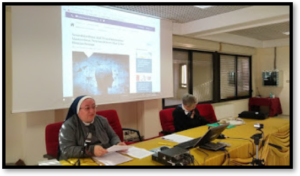 In the resurrection, the soul will reshape the matter in that same form that «virtually preserves in itself», our corporeity will be transfigured and renewed on the model of Christ. The encounter with Christ marks a new life and following of Christ reveals the vocation to immortality, a call to eternal life. The Catholic Church affirms that there is a resurrection: our body preserves its identity in it and the human Ego subsists and survives, despite the dissolution of the body. Through Christ’s victory over death, which becomes a liberation and fulfillment. Here death, suffering, and pain finds new meaning and eternal life perpetuates the call to live with Christ, a communion that makes all other relationships more complete and alive.
In the resurrection, the soul will reshape the matter in that same form that «virtually preserves in itself», our corporeity will be transfigured and renewed on the model of Christ. The encounter with Christ marks a new life and following of Christ reveals the vocation to immortality, a call to eternal life. The Catholic Church affirms that there is a resurrection: our body preserves its identity in it and the human Ego subsists and survives, despite the dissolution of the body. Through Christ’s victory over death, which becomes a liberation and fulfillment. Here death, suffering, and pain finds new meaning and eternal life perpetuates the call to live with Christ, a communion that makes all other relationships more complete and alive. At the conclusion of the round-table seminar, there was a debate on the ideas of the “Letter Placuit Deo to the Bishops of the Catholic Church on Certain Aspects of Christian Salvation” of the Congregation for the Doctrine of the Faith, in which explicit reference is made to two tendencies now widely spread, or from which certain school of thought seem to draw inspiration: neo-Pelagianism and neo-Gnosticism. The first consists in man’s effort to achieve salvation by himself, observable in the way he uses (or becomes a servant of) the technique, then robotics, technologies, etc; the second seeks a subjective salvation through the liberation from the body. Transhumanism contains tendencies toward both of these two approaches, «two temptations of the human being».
At the conclusion of the round-table seminar, there was a debate on the ideas of the “Letter Placuit Deo to the Bishops of the Catholic Church on Certain Aspects of Christian Salvation” of the Congregation for the Doctrine of the Faith, in which explicit reference is made to two tendencies now widely spread, or from which certain school of thought seem to draw inspiration: neo-Pelagianism and neo-Gnosticism. The first consists in man’s effort to achieve salvation by himself, observable in the way he uses (or becomes a servant of) the technique, then robotics, technologies, etc; the second seeks a subjective salvation through the liberation from the body. Transhumanism contains tendencies toward both of these two approaches, «two temptations of the human being».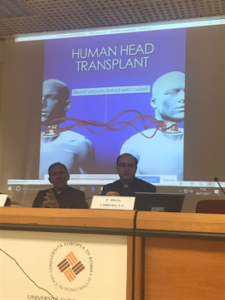 During the introductory presentation, the steps already taken during previous lessons has been recalled: the so-called head transplantation is close; probable and craved transhumanist goal, which stresses out the minds of those who are following its development. The whole philosophy from which Canavero’s experimentation originates, however, is the same which stands behind the famous “2045 Initiative”, whose cultural assumptions are strongly critical about contemporary society; reason why redemption has to come through a new kind of humanity, achievable during the era of digital immortality. Anxiety and hope are the two opposing reactions and perceptions generated by this future vision of humanity, who is tottering between her own improvement and the danger that, while trying to reach this improvement through the “Immortality Project”, she would no longer fully recognize her human nature, at the point to risk to lose it. The imminence of the problematic issues about objects of neuroethics interest (personal autonomy, privacy, subjective identity, rights and equality in the therapeutic field related to the costs that such interventions would require, etc..) is already an international political discussion item.
During the introductory presentation, the steps already taken during previous lessons has been recalled: the so-called head transplantation is close; probable and craved transhumanist goal, which stresses out the minds of those who are following its development. The whole philosophy from which Canavero’s experimentation originates, however, is the same which stands behind the famous “2045 Initiative”, whose cultural assumptions are strongly critical about contemporary society; reason why redemption has to come through a new kind of humanity, achievable during the era of digital immortality. Anxiety and hope are the two opposing reactions and perceptions generated by this future vision of humanity, who is tottering between her own improvement and the danger that, while trying to reach this improvement through the “Immortality Project”, she would no longer fully recognize her human nature, at the point to risk to lose it. The imminence of the problematic issues about objects of neuroethics interest (personal autonomy, privacy, subjective identity, rights and equality in the therapeutic field related to the costs that such interventions would require, etc..) is already an international political discussion item.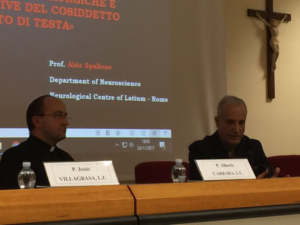 What explained by the esteemed neurosurgeon Aldo Spallone traces the academic and professional history of his colleague Canavero, pointing the link between his actual project “Heaven/Gemini”, in addition to his purpose, scheduled for 2020, to transplant a human brain into a machine (producing so a new humankind), and his concern, his particular awareness towards the issue of pain in the early days of his career, following the path which inspired his study of this issue. The Turinese neurosurgeon, along with his Chinese colleague Ren Xiaoting, proposes a series of “smoky” experiments, considered so by most of the scientific community, related in their technical aspect to standardized protocols, adopted without mitigating preexisting doubts about certain steps, such as for using the “sealant PEG”, whose function is to ensure the restoration of the integrity of the cutted nervous fiber; a technical device source of widespread skepticism.
What explained by the esteemed neurosurgeon Aldo Spallone traces the academic and professional history of his colleague Canavero, pointing the link between his actual project “Heaven/Gemini”, in addition to his purpose, scheduled for 2020, to transplant a human brain into a machine (producing so a new humankind), and his concern, his particular awareness towards the issue of pain in the early days of his career, following the path which inspired his study of this issue. The Turinese neurosurgeon, along with his Chinese colleague Ren Xiaoting, proposes a series of “smoky” experiments, considered so by most of the scientific community, related in their technical aspect to standardized protocols, adopted without mitigating preexisting doubts about certain steps, such as for using the “sealant PEG”, whose function is to ensure the restoration of the integrity of the cutted nervous fiber; a technical device source of widespread skepticism. There are therefore some strong perplexities about timings of the attempt set for next 17th December: it seems that different personalities from the scientific community consider the attempt premature, particularly because of the problematic glitch that the connection between the two spinal marrows represents. Even admitting its success, there are three possible scenarios: the transplantion is successful, but the patient doesn’t regain consciousness; the patient regains consciousness, but it is unknown what will happen to the marrow (it’s an high section cervical transplantation where the survival rate on average is 4 years circa); head and spinal marrow work correctly and Canavero successfully reaches his goal (evidently the last two hypothesis feed cultural, legal, geopolitical, spiritual, philosophical, bioethical, etc… issues, the same analyzed during the masterclass).
There are therefore some strong perplexities about timings of the attempt set for next 17th December: it seems that different personalities from the scientific community consider the attempt premature, particularly because of the problematic glitch that the connection between the two spinal marrows represents. Even admitting its success, there are three possible scenarios: the transplantion is successful, but the patient doesn’t regain consciousness; the patient regains consciousness, but it is unknown what will happen to the marrow (it’s an high section cervical transplantation where the survival rate on average is 4 years circa); head and spinal marrow work correctly and Canavero successfully reaches his goal (evidently the last two hypothesis feed cultural, legal, geopolitical, spiritual, philosophical, bioethical, etc… issues, the same analyzed during the masterclass).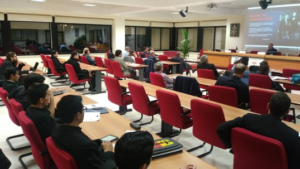 Clearly it is necessary, beyond the feasibility of the procedure, to dwell on “who” will be the “patient-hybrid” resulting from the procedure, main theme of the philosophical inquiry along with the purely bioethical consideration on the definitory frontier between health and disease, therapeutic and non-therapeutic, which additionally lies in the gap between Ren and Canavero, where the first one intends purely therapeutic purposes; the second instead publicly admitted his former support to the “2045 Initiative” or, in simple terms, intends to pursue immortality. How cleverly introduced by the Rector of the Pontifical Atheneum Regina Apostolorum, F. Jesús Villagrasa, and then recalled by the Director of the UNESCO Chair in Bioethics and Human Rights, the jurist Alberto García, the emergency engraved in these “radical medical interventions” would relapse on many fronts. Head transplantation specifically demands more careful sensitivities to the informed consent involved between the subjects, patients, each one coming from different and varied contexts (politically and culturally), suffering from serious and debilitating illnesses; therefore it becomes more urgent to take on responsibility, already fully accepted and exercised during the dialogue between many areas and sectors involved in the same conversation, if we consider it in light of the person, of her centrality and her human, ethical values, which affect and wholly define her; the same values recognized by law as a tool of safeguard and guarantee, which are enduring over the possible innovations, promoting a reflection on their own “ethicality”.
Clearly it is necessary, beyond the feasibility of the procedure, to dwell on “who” will be the “patient-hybrid” resulting from the procedure, main theme of the philosophical inquiry along with the purely bioethical consideration on the definitory frontier between health and disease, therapeutic and non-therapeutic, which additionally lies in the gap between Ren and Canavero, where the first one intends purely therapeutic purposes; the second instead publicly admitted his former support to the “2045 Initiative” or, in simple terms, intends to pursue immortality. How cleverly introduced by the Rector of the Pontifical Atheneum Regina Apostolorum, F. Jesús Villagrasa, and then recalled by the Director of the UNESCO Chair in Bioethics and Human Rights, the jurist Alberto García, the emergency engraved in these “radical medical interventions” would relapse on many fronts. Head transplantation specifically demands more careful sensitivities to the informed consent involved between the subjects, patients, each one coming from different and varied contexts (politically and culturally), suffering from serious and debilitating illnesses; therefore it becomes more urgent to take on responsibility, already fully accepted and exercised during the dialogue between many areas and sectors involved in the same conversation, if we consider it in light of the person, of her centrality and her human, ethical values, which affect and wholly define her; the same values recognized by law as a tool of safeguard and guarantee, which are enduring over the possible innovations, promoting a reflection on their own “ethicality”.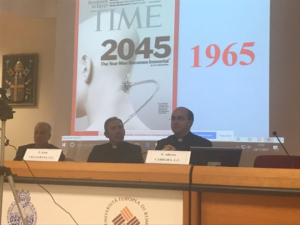 It’s fundamental to recompose the question about the purpose which leads to the use of human and material resources, in other words if the contribution to humanity have here a genuinely dystopian value, going to detriment of mankind while pushed from the power associated to progress, or if, on the other hand, it could be ethically thinkable (or even needed) such a medical intervention, in order to combine what presented and waited for the next December with medicine’s proper therapeutic vocation and with a research at the service of mankind, because she loves mankind. We need to discern the nature of the body-head transplantation with critical thinking. What was said during the third meeting of the first masterclass in Neurobioethics leads us to reevaluate the meaning of limit as an humankind distinctive element, in order to not run in the shadows of a new ethic of in-equality.
It’s fundamental to recompose the question about the purpose which leads to the use of human and material resources, in other words if the contribution to humanity have here a genuinely dystopian value, going to detriment of mankind while pushed from the power associated to progress, or if, on the other hand, it could be ethically thinkable (or even needed) such a medical intervention, in order to combine what presented and waited for the next December with medicine’s proper therapeutic vocation and with a research at the service of mankind, because she loves mankind. We need to discern the nature of the body-head transplantation with critical thinking. What was said during the third meeting of the first masterclass in Neurobioethics leads us to reevaluate the meaning of limit as an humankind distinctive element, in order to not run in the shadows of a new ethic of in-equality.